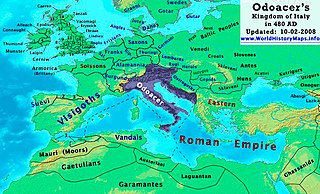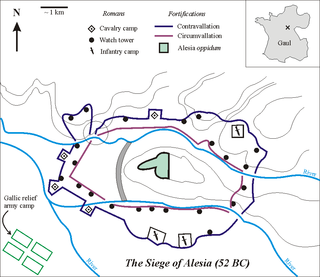The Julian calendar, proposed by Julius Caesar in AUC 708, was a reform of the Roman calendar. It took effect on 1 January AUC 709 , by edict. It was designed with the aid of Greek mathematicians and astronomers such as Sosigenes of Alexandria.
AD 68 (LXVIII) was a leap year starting on Friday of the Julian calendar. At the time, it was known as the Year of the Consulship of Silius Italicus and Trachalus, or the start of the Year of the Four Emperors. The denomination AD 68 for this year has been used since the early medieval period, when the Anno Domini calendar era became the prevalent method in Europe for naming years. These are now used throughout the world.
AD 7 was a common year starting on Saturday of the Julian calendar. In the Roman Empire, it was known as the Year of the Consulship of Metellus and Nerva. The denomination "AD 7" for this year has been used since the early medieval period, when the Anno Domini calendar era became the prevalent method in Europe for naming years.

Year 480 (CDLXXX) was a leap year starting on Tuesday of the Julian calendar. At the time, it was known as the Year of the Consulship of Basilius without colleague. The denomination 480 for this year has been used since the early medieval period, when the Anno Domini calendar era became the prevalent method in Europe for naming years.
AD 38 (XXXVIII) was a common year starting on Wednesday of the Julian calendar. At the time, it was known as the Year of the Consulship of Iulianus and Asprenas. The denomination AD 38 for this year has been used since the early medieval period, when the Anno Domini calendar era became the prevalent method in Europe for naming years.
AD 40 (XL) was a leap year starting on Friday of the Julian calendar. At the time, it was known as the Year of the Consulship of Augustus without colleague. The denomination AD 40 for this year has been used since the Early Middle Ages, when the Anno Domini calendar era became the prevalent method in Europe for naming years.
AD 45 (XLV) was a common year starting on Friday of the Julian calendar. At the time, it was known as the Year of the Consulship of Vinicius and Corvinus. The denomination AD 45 for this year has been used since the early medieval period, when the Anno Domini calendar era became the prevalent method in Europe for naming years.

AD 50 (L) was a common year starting on Thursday of the Julian calendar. At the time it was known in Europe as the Year of the Consulship of Vetus and Nerullinus. The denomination AD 50 for this year has been used since the Early Middle Ages, when the Anno Domini calendar era became the prevalent method in Europe for naming years.
AD 64 (LXIV) was a leap year starting on Sunday of the Julian calendar, the 64th Year of the Anno Domini designation, the 64th year of the 1st millennium, the 64th year of the 1st century, and the 4th year of the 7th decade. At the time, it was known as the Year of the Consulship of Bassus and Crassus. The denomination AD 64 for this year has been used since the early medieval period, when the Anno Domini calendar era became the prevalent method in Europe for naming years.
AD 65 (LXV) was a common year starting on Tuesday of the Julian calendar. At the time, it was known as the Year of the Consulship of Nerva and Vestinus. The denomination AD 65 for this year has been used since the early medieval period, when the Anno Domini calendar era became the prevalent method in Europe for naming years.
AD 75 (LXXV) was a common year starting on Sunday of the Julian calendar. At the time, it was known as the Year of the Consulship of Augustus and Vespasianus. The denomination AD 75 for this year has been used since the early medieval period, when the Anno Domini calendar era became the prevalent method in Europe for naming years.
AD 78 (LXXVIII) was a common year starting on Thursday of the Julian calendar. At the time, it was known as the Year of the Consulship of Novius and Commodus. The denomination AD 78 for this year has been used since the early medieval period, when the Anno Domini calendar era became the prevalent method in Europe for naming years.

AD 80 (LXXX) was a leap year starting on Saturday of the Julian calendar. At the time, it was known as the Year of the Consulship of Augustus and Domitianus. The denomination AD 80 for this year has been used since the early medieval period, when the Anno Domini calendar era became the prevalent method in Europe for naming years.
AD 90 (XC) was a common year starting on Friday of the Julian calendar. At the time, it was known as the Year of the Consulship of Domitian and Nerva. The denomination AD 90 for this year has been used since the early medieval period, when the Anno Domini calendar era became the prevalent method in Europe for naming years.

AD 100 (C) was a leap year starting on Wednesday of the Julian calendar. In the Roman Empire, it was sometimes referred to as year 853 ab urbe condita, i.e., 853 years since the founding of Rome in 753 B.C. The denomination AD 100 for this year has been used since the early medieval period, when the Anno Domini calendar era became the prevalent method in Europe for naming years.

Year 280 (CCLXXX) was a leap year starting on Thursday of the Julian calendar. At the time, it was known as the Year of the Consulship of Messalla and Gratus. The denomination 280 for this year has been used since the early medieval period, when the Anno Domini calendar era became the prevalent method in Europe for naming years.

Year 50 BC was a year of the pre-Julian Roman calendar. At the time, it was known as the Year of the Consulship of Paullus and Marcellus. The denomination 50 BC for this year has been used since the early medieval period, when the Anno Domini calendar era became the prevalent method in Europe for naming years.

Year 52 BC was a year of the pre-Julian Roman calendar. At the time, it was known as the Year of the Consulship of Pompeius and Scipio. The denomination 52 BC for this year has been used since the early medieval period, when the Anno Domini calendar era became the prevalent method in Europe for naming years.
Year 54 BC was a year of the pre-Julian Roman calendar. At the time, it was known as the Year of the Consulship of Appius and Ahenobarbus. The denomination 54 BC for this year has been used since the early medieval period, when the Anno Domini calendar era became the prevalent method in Europe for naming years.






